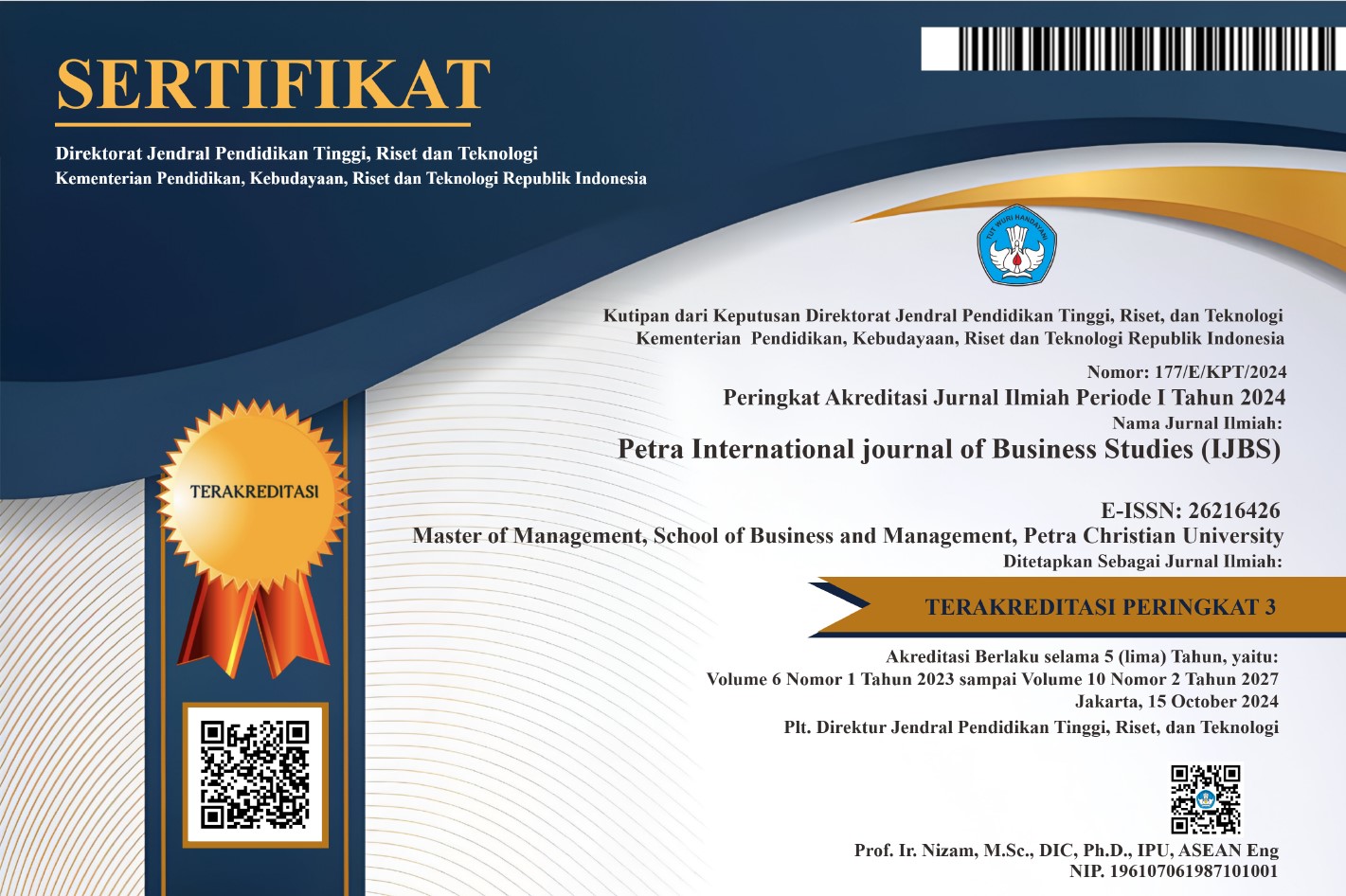Exploring Hospital Supply Chain Partnership Factors and Its Impact on Overall Supply Chain Performance
DOI:
https://doi.org/10.9744/petraijbs.6.2.213-225Keywords:
Hospital, Supply Chain, Partnership, Supplier, GovernmentAbstract
Hospitals function as complex businesses with intricate supply chain networks involving collaboration among various entities to efficiently deliver information, goods, and services to end customers. This study investigates the causal relationships between hospitals, suppliers, and government entities within the supply chain network. Employing system thinking, system dynamics, and causal-loop diagrams, it assesses how coordination, collaboration, and integration impact hospital supply chain performance. The findings reveal that high coordination and collaboration among suppliers, hospitals, and government entities positively influences supply chain performance. The study identifies key factors contributing to effective partnerships, such as information sharing, trust levels, supplier quality standards, inventory capabilities, flexibility, pricing strategies, and IT integration. Additionally, the research considers hospitals' dynamic capabilities, key performance results, patient outcomes, government healthcare spending, regulations, and economic indicators. Managerial implications emphasize the importance of strong partnerships to enhance overall supply chain performance, potentially improving patient outcomes and healthcare service quality. While acknowledging limitations, the study suggests future research avenues, including exploring the impact of other stakeholders and specific factors on hospital supply chain management.
Downloads
References
Abdallah, A. B., Abdullah, M. I., & Mahmoud Saleh, F. I. (2017, April 3). The effect of trust with suppliers on hospital supply chain performance. Benchmarking: An International Journal, 24(3), 694–715. doi: 10.1108/BIJ-05-2016-0062
Alshahrani, S., Rahman, S., & Chan, C. (2018, February 12). Hospital-supplier integration and hospital performance: Evidence from Saudi Arabia. The International Journal of Logistics Management, 29(1), 22–45. doi:10.1108/IJLM-12-2016-0287
Amissah, M., Gannon, T. F., & Monat, J. P. (2020, February 27). What is systems thinking? Expert Perspectives from the WPI Systems Thinking Colloquium of October 2, 2019. Systems; Multidisciplinary Digital Publishing Institute. doi: 10.3390/systems8010006
Azzi, A., Persona, A., Sgarbossa, F., & Bonin, M. (2013). Drug inventory management and distribution: Outsourcing logistics to third‐party providers. Strategic Outsourcing: An International Journal, 6(1), 48–64. doi: 10.1108/17538291311316063
Beerli, A., & Martín, J. D. (2004). Factors influencing destination image. Annals of Tourism Research, 31(3), 657-681. doi: 10.1504/IJLSM.2013.053773
Bian, W., Yang, X., Li, S., Yang, X., & Hua, G. (2021). Advantages of 3PLs as healthcare supply chain orchestrators. Computers & Industrial Engineering, 161, 107628. doi: 10.1016%2Fj.cie.2021.107628
Burns, R. Lawton. (2002). The healthcare value chain: Producers, purchasers, and providers. jossey-bass
Deshwal, P. (2016). Customer experience quality and demographic variables (Age, gender, education level, and family income) in retail stores. International Journal of Retail & Distribution Management, 44(9), 940-955. doi: 10.1108/IJRDM-03-2016-0031
Dobrzykowski, D. (2019, April). Understanding the downstream healthcare supply chain: unpacking regulatory and industry characteristics. Journal of Supply Chain Management, 55(2), 26–46. doi: 10.1111/jscm.12195
Malbon, E., & Parkhurst, J. (2023). System dynamics modeling and the use of evidence to inform policymaking. Policy Studies, 44(4), 454-472. doi: 10.1080/01442872.2022.2080814
Hair, J. F., Black, W. C., Babin, B. J., & Anderson, R. E. (2010). Multivariate data analysis: A global perspective (7th ed.). Upper Saddle River: Pearson Education.
Iacocca, K. M., & Mahar, S. (2018, August 6). Cooperative partnerships and pricing in the pharmaceutical supply chain. International Journal of Production Research, 57(6), 1724–1740. doi: 10.1007/s12351-021-00674-x
Kitsiou, S., Matopoulos, A., Manthou, V., & Vlachopoulou, M. (2007). Evaluation of integration technology approaches in the healthcare supply chain. International Journal of Value Chain Management, 1(4), 325–343. doi: 10.1504/IJVCM.2007.015091
Kuo, T. C., Chen, K. J., Shiang, W. J., Huang, P. B., Otieno, W., & Chiu, M. C. (2021). Collaborative data-driven analytics of material resource management in the smart supply chain by using a hybrid Industry 3.5 strategy. Resources, Conser¬vation and Recycling, 164, 105160. https://doi.org/10.1016/j.resconrec.2020.105160
Mandal, S. (2017, May 2). The influence of dynamic capabilities on hospital-supplier collaboration and hospital supply chain performance. International Journal of Operations & Production Management, 37(5), 664–684. doi: 10.1108/IJOPM-05-2016-0249
Mathew, J., John, J., & Kumar, S. (2013). New trends in the healthcare supply chain. In Annals of POMS conference proceedings, pp. 1-10. doi: 10.1007/s42943-021-00045-5
Matopoulos, A., & Michailidou, L. (2013). Implementing collaborative practices in the healthcare supply chain: insights into hospital-vendor operations. International Journal of Logistics Systems and Management, 15(2/3), 288.
Mettler, T. (2011, April 1). Transformation of the hospital supply chain. International Journal of Healthcare Information Systems and Informatics, 6(2), 1–13. doi: 10.4018/jhisi.2011040101
Mishra, V., Samuel, C., & Sharma, S. (2018, July 9). Supply chain partnership assessment of a diabetes clinic. International Journal of Health Care Quality Assurance, 31(6), 646–658. doi: 10.1108/IJHCQA-06-2017-0113
National Academy of Engineering (US) and Institute of Medicine (US) Committee on Engineering and the Health Care System, Reid, P. P., Compton, W. D., Grossman, J. H., & Fanjiang, G. (Eds.). (2005). Building a better delivery system: A New Engineering / Health Care Partner¬ship. National Academies Press (US). doi: 10.17226/11378
Pan, J., Liu, G. G., & Gao, C. (2013). How does separating government regulatory and operational control of public hospitals matter to healthcare supply? China Economic Review, 27, 1–14. doi: 10.1016/j.chieco.2013.07.002
Ryan, K. Jennifer. (2005). Systems engineering: Opportunities for health care, building a better delivery system: A new engineering / health care partnership. National Academy Press.
Setiawati, M., Sutopo, W., & Wijayanti, A. (2014). Hospital supply chain management: A literature review. International Journal of Applied Business Research, 2(2), 1-14.
Setyawan Firmansyah, H., & Siagian, H. (2022, December 15). Impact of information sharing on supply chain performance through supplier quality management, supply chain agility, and supply chain innovation. Petra International Journal of Business Studies, 5(2), 119–131. https://doi.org/10.9744/ijbs.5.2.119-131
Singh, A., & Parida, R. (2022). Decision-making models for healthcare supply chain disruptions: Review and insights for post-pandemic era. International Journal of Global Business and Competitiveness, 17(2), 130–141. doi: 10.1007/s42943-021-00045-5
Additional Files
Published
Issue
Section
License
Copyright (c) 2023 Marla Setiawati, Aiko Pasaribu, David Prasetya Halim, Juan Darmawan

This work is licensed under a Creative Commons Attribution 4.0 International License.
Petra IJBS (e-ISSN: 2621-6426) is published by Master of Management program, School of Business and Management, Petra Christian University, Indonesia (MM SBM PCU).












